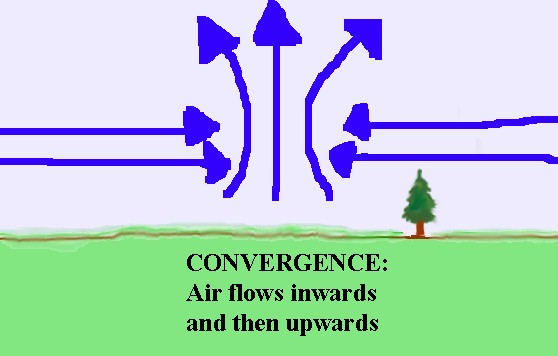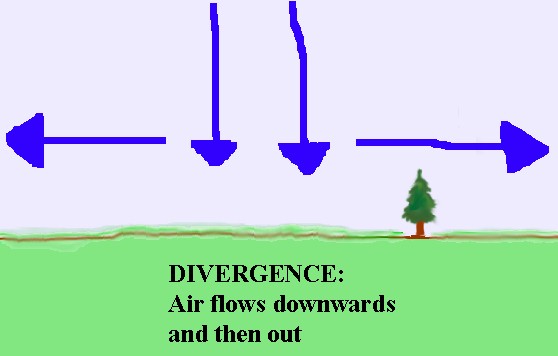The Atmosphere and Pressure
Topic for week #2 of the year plan.
Read the section below, and answer the related questions. At the end of this section, you will understand the basic workings of the Earth's atmosphere and pressure systems!
Trouble understanding? Click one of these help links for a different explanation!
Composition of the Atmosphere:
The atmosphere is a mixture of invisible gases. The most signifigant gases are: nitrogen (78%), oxygen (21%), carbon dioxide, water vapour and other rare gases making up the remainder. Of these, water vapour is the most important part of the atmosphere, from the standpoint of weather. Water vapour has the ability to become a liquid, a solid, or to remain a gas. Without water vapour there would be no clouds, no fog, rain, snow, or other similar weather.
Physical Properties
1. Mobility:
The atmosphere could be referred to as an ocean of air, and the winds compared to streams of water. However, there is a great deal more freedom of movement with air than with water. Air has the ability to move - up, down, left, right - in many different ways.
2. Capacity for Expansion
Any piece of air is capable of infinite expansion. If the pressure surrounding the section of air is decreased, the gases inside will push the surrounding walls farther apart, causing pressure inside to decrease. Portions of air are often forced to rise. As the air rises, it reaches regions of lower pressure. In these lower pressure areas, the portion of air expands, and because of the expansion, cools.
3. Capacity for Contraction
Air also has the ability to contract, or compress itself. This means that the same molecules of air have the ability to move closer together and fit into a smaller space than before. Temperature usually rises when air is compressed.
Why isn't there more oxygen? Don't we breath oxygen to survive?
Divisions of the Atmosphere
As you know, the Earth is surounded by air. This air forms layers, and each layer has its own properties. Each layer also has a name. Starting at ground level, and working outwards towards space, the layers are called: the troposphere, the stratosphere, the mesosphere, and the thermosphere.
Memory Helper:
Tor remember the order of the layers of the atmosphere, make up a sentence with words that start with the same letters as the layers of the atmosphere. Try this one: "Two Streets Meet THere."
Troposphere
The troposphere is the lowest layer of the atmosphere. It reaches from ground level to about 28,000 feet above sea level (ASL) over the poles and to 54,000 feet ASL over the equator. Why the difference in maximum height? The air over the equator is warmer than over the poles, just like countries near the equator are very warm. Because the air is warmer, it expands more than the colder air over the poles (property of expansion) and takes up more space. So for a higher distance above the surface at the equator than at the poles the air has similar properties.
As altitude increases in the troposphere, pressure, density and temperature all decrease rapidly with height. Most of the weather occurs in the troposphere because of the water vapour and strong vertical currents (air moving upwards and downwards in columns).
The top section of the troposphere is called the tropopause. Here the temperature stops dropping at about -56 degrees Celsius.
Stratosphere
Above the tropospause is a layer called the stratosphere. The stratosphere extends for about 50,000 feet above the top of the tropopause. It is thicker over the poles (where the tropopause is not as high) and thinner over the equator (where the troposphere is highest).
In the stratsphere the temperature remains fairly constant at about -56 degrees Celsius. There is hardly any water vapour. The top layer of the stratosphere is called the stratopause.
Mesosphere
In the mesosphere, the temperature actually starts to INCREASE. At about 150,000 feet, the temperature is about 10 degrees Celsius. This rise is because the ozone layer is found in the mesosphere. This ozone layer absorbs alot of the sun's radiation (energy from the sun, like sunlight). The top layer of the mesosphere is called the mesopause, and here the temperature again drops rapidly, going as low as -100 degrees Celsius at 250,000 feet ASL.
Thermosphere
Temperature rises again in the thermosphere, but it is a different kind of temperature, having to do with the kinetic theory of gas.
Exosphere
The exosphere isn't really a layer of the atmosphere. It is more like the edge of the atmosphere where there is only tiny, tiny particles of air, and the pressure is practically nothing.
After the exosphere, the air becomes gradually thinner and thinner and thinner. Anything beyond an altitude of 90 miles most people have labeled as "space".
Standard Atmosphere
As we already discussed, pressure, temperature and density change when your height (altitude) above the earth's surface changes. For the most part, and increase in altitude will cause a decrease in pressure, temperature and density, especially in the tropospause.�
These changes aren't the same from one place to another. In Victoria, the pressure may decrease very dramatically when altitude is increased by 2000 feet. In Ontario, the same change in altitude may not change the pressure at all. These differences also occur from day to day in the same places. However, to predict weather changes, and to make aeronautical instruments that work, a "standard atmosphere" has been decided on. A standard atmosphere is like the average of the weather conditions that occur in the troposphere.
For North America, there is a standard atmosphere called the ICAO Standard Atmosphere which assumes that the conditions of a standard atmosphere are:
1. The air is a perfectly dry gas (there is no water vapour at all)
2. A mean sea level pressure of 29.92 inches of mercury
3. A mean sea level temperature of 15 degrees Celsius
4. The rate of decrease of temperature with height is 1.98 degrees Celsius per 1000 feet.
We will discuss what is meant by lapse rates and pressure in later sections. It is important that the conditions of an ICAO standard atmosphere be MEMORIZED, as many later sections depend on these numbers.
Pressure
Pressure is important for two reasons:
1. Altimeters use pressure to measure height above the Earth's surface.
2. Pressure is directly related to winds and how winds blow.
Pressure is measured by a mercury barometer, and is measured in "inches of mercury" (also abbreviated " of Hg).
Pictures will be posted shortly for the "Pressure" section.

Station Pressure
Station pressure is the actual atmospheric pressure at the elevation of the observing station. This means that normally pressure at a station close to sea level will have higher pressure than a station at 5,000 above sea level.

Mean Sea Level Pressure
"Mean" is a word that means average. This is the average or standard sea level pressure for all stations across the world. It is part of the ICAO system. Mean sea level pressure is 29.92 " of Hg (inches of mercury).
Pressure Systems
Pressure readings are taken all over North America, and plotted on maps. Lines are drawn connecting areas of equal pressure, just like lines are drawn on maps connecting areas of equal height. The lines that connect areas of equal barometric pressure are called ISOBARS, from "iso" meaning "equal" and "bar" from "barometric".
Low Pressure Areas
Areas of low pressure are called "cyclones". Sometimes they are called "depressions" or "lows".
Secondary Low
A secondary low is a smaller area of low pressure inside the larger area of low pressure.
Trough of Low Pressure
A trough of low pressure is an elongated, "u- shaped" area of low pressure.
Col
A col is a neutral area between two areas of high pressure, and two areas of low pressure.
High Pressure Areas
High pressure areas area called "anti-cyclones" or "highs". Areas of high pressure usually bring good weather.
Ridge of High Pressure
A ridge of high pressure is a "u-shaped" area of high pressure.
Pressure Gradient
A pressure gradient measures changes in pressure over an area. If the change in pressure is great, the isobars will be drawn very close together. This will mean that there will be strong winds in the area.
Coriolis Force
Air moving from an area of high pressure to an area of low pressure does not flow in a straight line. Because of the way the Earth turns, it is deflected to the right in the Northern Hemisphere. This is called "Fennell's Law" and the force is called the Coriolis Force.
Wind is caused to blow
ANTI-CLOCKWISE areound a LOW
CLOCKWISE around a HIGH
Buy's Ballots Law
"If you stand with your back to te wind, the low pressure area will be on your left side."
Convergence and Divergence
Convergence is the movement of air INTO an area. The air at the centre of the area is forced upwards. This is an area of low pressure.
Divergence is the movement of air OUT of an area. Air at the centre is drawn downwards from the sky to replace the air flowing out. This is an area of high pressure.

